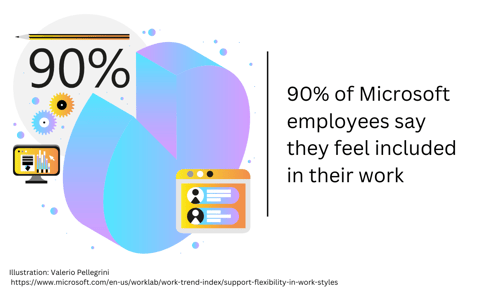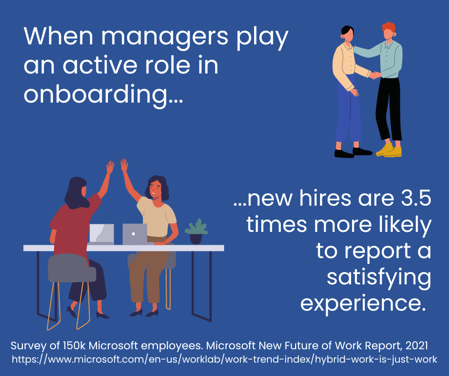Microsoft’s people analytics team predicted a hit to the new hire experience when they went to virtual employee onboarding in 2020. But thanks to a new management framework launched less than a year earlier - they were wrong. Not only did new hires report satisfaction with their onboarding experience, but managers were even more involved.[1] So, what’s this management framework and how can you use it to level up your onboarding process? Read on to find out.
Microsoft’s Model, Coach, Care Management Framework
Leaders at Microsoft set out to redefine the role of a manager. It took two years of deliberating and conducting interviews, surveys, and focus groups. Finally, the role of a Microsoft manager was redefined as “delivering success through empowerment and accountability by modeling, coaching, and caring.”[2] Following is a brief description of the three components of the framework: Model, coach, and care.
Microsoft's Managers Model
As it sounds, modeling is best described by the adage, “walk the walk.” Managers model company culture, values, and leadership principles by living and embodying them. They encourage employees to do the same by example, not just by directive. But it doesn’t end there. Managers are expected to identify their own opportunities for growth as a manager and shift their approach as needed.
Microsoft's Managers Coach
Managers extend their responsibilities beyond mere compliance and enforcement to coaching employees to be the best version of themselves. First, they define team objectives and outcomes. Second, they enable success across boundaries by encouraging teamwork with the whole organizational team. Third, they help teams adapt and learn. Not by providing solutions but by coaching their team to develop solutions. Coaching leads to higher productivity, connection with the team, and overall happiness in the workplace. 
Microsoft's Managers Care
Microsoft managers are expected to make employees feel valued and cared for. They do this in three main ways. First, they strive to attract and retain great talent by being intentional about building connections and being enthusiastic about opportunities. Second, they make time to connect and listen while helping each team member align their purpose to the company mission. Their goal is to know their teams’ aspirations and capabilities. Finally, they invest in the growth of others by guiding them with high-quality connections and performance discussions.
The Role of Managers in Employee Onboarding
"Managers hold the dial that brings everything into focus, especially in a time of hybrid work. In short, managers matter more than ever." ~Microsoft New Future of Work Report, 2021
The pandemic was the ultimate test of Microsoft’s new management framework. Would it hold up under the move from in-person to virtual onboarding? It passed with flying colors – in large part to the participation of managers.
Microsoft’s people analytics team was particularly interested in how the shift to remote working would impact employees. Consistent employee feedback surveys were used to gather data throughout the process.
Based on onboarding surveys from more than 25,000 employees they were surprised to learn that the onboarding experience was going well – despite being virtual. New hires whose managers played an active role were 3.5 times more likely to be satisfied with their onboarding experience.[4]

Implement Microsoft’s Management Framework in Employee Onboarding
You can implement the model, coach, care management framework into your organization’s employee onboarding process to set the stage for success. Each component of the management framework and how it can be integrated into your employee onboarding process are summarized below.
Modeling increases employee confidence

From the first communications with job candidates, it is imperative that the company culture, values, and leadership principles are modeled. This provides clear expectations for candidates to determine whether the company is a good fit.
Here are two ways to incorporate modeling in the onboarding process:
- Managers can send new hires videos or materials depicting company culture and share how it has impacted their life. For example, a manager from Microsoft might share a story about how the organization’s emphasis on a growth mindset influenced their decision to learn a new personal skill they previously considered unachievable.
- Schedule time in the onboarding schedule for managers to discuss and define leadership principles with new hires. Leadership is something that all employees should be expected to emulate. Presented well, this will be an exciting growth opportunity.
Coaching strengthens employee clarification
.png?width=356&height=299&name=90%25%20of%20Microsoft%20employees%20say%20theiy%20feel%20included%20in%20their%20work%20(1).png)
“Our data show that new hires who are clear about what’s expected of them had a better onboarding experience. Less was left on the table" said Dawn Klinghoffer, MS Head of People Analytics. [5] Coaching helps set clear expectations around roles and responsibilities. This is a key aspect of onboarding satisfaction among new hires. No one wants to be left in the dark and unsure of what is expected of them.
Here are two ways to implement coaching into the onboarding process and get off to a good start:
- Provide ample opportunity for two-way feedback between the new hire and their manager to identify training and coaching needs as they arise. Include regular one-on-one meetings and feedback surveys during the onboarding period and beyond.
- Create an environment of shared success between departments by introducing new hires to colleagues from different departments and office locations. Establish common goals and missions across departments. Microsoft refers to its team as “One Microsoft" to prevent silos and adversarial relationships.
Caring builds team connection
.png?width=334&height=280&name=90%25%20of%20Microsoft%20employees%20say%20theiy%20feel%20included%20in%20their%20work%20(2).png)
Managers have gotten a bad rap in recent years. Often characterized as burnt out, absent, or toxic, the perception of managers needs an overhaul. The onboarding period is an opportunity to show new hires that management is synonymous with mentorship and coaching.
Here are two ways to implement caring into the onboarding process and make a good impression:
- Make a connection before the first day. Microsoft recommends, "Position managers as the first line of support for those who are new to the company."[6] It is crucial to develop that connection in the pre-boarding phase with a personal introduction from managers.
- Schedule time within the first two weeks for managers to learn about each new hire’s personal and professional goals. What do they hope to accomplish at the organization? What does work-life balance look like to them?
Get more insights from Microsoft’s research by reading, “Microsoft’s Future of Work: 6 C’s of Employee Onboarding is Essential.”
Launch your onboarding program in a week
Rome wasn’t built in a day and your employee onboarding program won’t be perfect in a week. But the only way to get there is to begin. Start with the basics and build it from there based on knowledge and data gained along the way.
Read our six-step guide to launch your onboarding program in less than a week to get started right away. We have lined out the basic steps and incorporated the 6 C’s of onboarding to get you off to a strong start.
Have a question about onboarding?
It can be daunting to get an onboarding process off the ground. Preppio's onboarding experts are here to help. Just drop us a line.
REFERENCES
[1] https://www.microsoft.com/en-us/worklab/work-trend-index/managers-keep-teams-connected
[2] https://culture.io/resources/developing-growth-mindset/
[3] https://www.microsoft.com/en-us/worklab/work-trend-index/managers-keep-teams-connected
[4] https://www.microsoft.com/en-us/worklab/work-trend-index/managers-keep-teams-connected
[5] https://www.microsoft.com/en-us/worklab/work-trend-index/managers-keep-teams-connected
[6] https://www.microsoft.com/en-us/worklab/work-trend-index/managers-keep-teams-connected
.png?width=309&height=174&name=Untitled%20design%20(36).png)